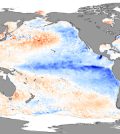Posts for tag "Washington State University"
Some Prehistoric Humans Survived On Salmon Year Round
Prehistoric humans living near modern-day British Columbia were able to forego migrating and survive year round in one place, a rarity, on salmon.
- Posted October 31, 2016
Carbon Emissions From Lakes Greatly Underestimated
An eddy covariance system in Mississippi’s Ross Barnett Reservoir reveals that some carbon emissions from lakes have been overlooked by previous studies.
- Posted June 14, 2016
Transition To La Niña Seems Likely
With El Niño waning, a question on the mind of a few meteorologists is whether La Niña will take its place. According to a release from Washington State University, the data indicate that La Niña is probably...
- Posted May 5, 2016
‘Cyberforests’ Could Help Predict Future Of North American Forests
It can take 1,000 years for a forest to grow on its own. But thanks to a modeling approach, researchers at Washington State University can grow a digital version in just three weeks. The forests that they...
- Posted March 4, 2016
Piecing Together Riparian Corridor Puzzle Could Provide Species Benefits
Washington State scientists use GIS data, hydrography maps in an ongoing attempt to encourage connection of riparian corridors and help species flourish.
- Posted November 10, 2015
Washington State University Weather Network Records Warmest May Since 1993
The AgWeatherNet weather network supported by Washington State University recorded some interesting weather changes in Washington over the course of spring 2015, according to a release from the school. Among them was the warmest May on record...
- Posted June 29, 2015
Wind storm over dry lake bed confirmed cause of mysterious milky rain in Pacific NW
Last February, an unusual rain descended upon parts of the Pacific Northwest, coating affected regions with a milky residue. A team of researchers from Washington State University say that dust from a dry lake bed nearly 500...
- Posted June 17, 2015
Scientists search for endangered Yangtze softshell turtle with eDNA
Researchers at Washington State University are using environmental DNA to help save the world’s largest freshwater turtle from extinction, according to a release from the school. Their study will focus on the Yangtze softshell, the world’s largest...
- Posted March 9, 2015










